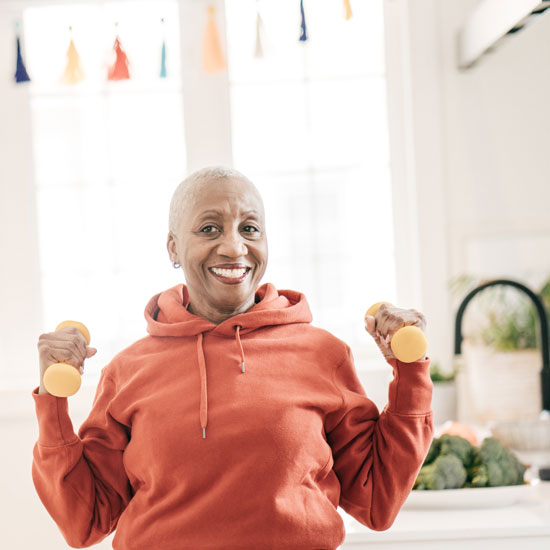
Just because the gyms and recreation centers are closed these days doesn’t mean you can’t exercise. We hope the following information is helpful to you and your family in this time of change.
When asked the question, "Do you exercise?," many of us would probably answer yes. You may explain that you are active throughout the day with your job, completing chores around the house or doing yard work.
"What many people don't understand," says Lauren White, physician assistant at the Nebraska Medicine Bariatrics Center, "is the difference between physical activity and intentional exercise. Physical activity is any movement that requires energy. Intentional exercise, on the other hand, is a structured, planned, repetitive movement that improves overall health and is the most effective means of losing weight and keeping it off."
Schedule an appointment
Call 402.559.9500 for an appointment to speak with a weight loss specialist.
Exercise also provides many other health benefits, adds White. It can help lower blood sugars, improve cholesterol and lower blood pressure, as well as reduce your risk for heart attacks, strokes, diabetes, colon cancer, osteoporosis and fractures, obesity, depression and even dementia. It’s also a stress reducer. Exercise reduces levels of stress hormones in the body and stimulates chemicals in the brain that are mood enhancers.
Still need more reasons to make time for intentional exercise? "Studies show that sitting for more than a one-hour chunk of time can sabotage your weight loss efforts," says Heather Shafer, MS, Nebraska Medicine exercise physiologist. "After an hour of sitting, the hormone leptin, which tells your fat cells to grow, increases, as does the hormone ghrelin, which increases your appetite. If you have a job that requires you to sit most of the day, make a point to get up and move around every hour."
There are many benefits to incorporating intentional exercise into your daily routine, says Shafer. For maximum health benefits, the American Heart Association recommends getting at least 150 minutes of moderate exercise each week, or 75 minutes weekly of vigorous exercise. This can be divided into 30 minutes a day, five days a week for moderate exercise, or 15 minutes a day, five days a week for vigorous exercise.
"You don’t need to go to a gym or have fancy exercise equipment to exercise," says Shafer. "Try starting with low-intensity exercise such as walking and gradually increase your time. You can also work in chunks of exercise as you go about your daily routine. Exercising in as little as 10 minutes bouts of time can be effective in improving overall health." Shafer offers these ideas:
- When you go out to get the newspaper, take a brisk 5 to 10 minute power walk
- While house cleaning, work in an occasional 5 to 10 minutes of jumping jacks or mountain climbers
- While cooking dinner, do some push-ups against the counter or wall while you are waiting for the water to boil
- You can stroll through parks and down streets in your neighborhood. Just maintain six feet of separation from others.
Work toward becoming more intentional about your exercise."Consistency is key,” says Shafer. “It’s better to exercise in short bouts throughout the week, than once a week for 30 minutes. Choosing exercise that you know you will do, will help you be more consistent."
Shafer also recommends working strength training into your routine in your home at least two to three times a week. Strength training increases muscle mass, which increases your resting metabolic rate and burns more calories. She suggests these exercises to help you work all of the major muscle groups.
- Wall pushups – Stand in front of a wall and lift your arms to shoulder level. Push off the wall and then lower yourself to the wall again
- Wall sits – Standing with your back against a wall, slowly lower your body down into a sitting position with your knees above your ankles. Gradually increase the amount of time you hold yourself in that position
- Planks – Lie face down with your hands or forearms on the floor and your legs extended. Press yourself up to form a straight line with your body and hold, gradually increasing your hold time
- Calf raiser – Rise up on your toes and repeat. You can also stand on the edge of a step and raise your heels
- Superman – Lying face down, raise your arms and legs in an outstretched position and hold
- Sit-ups – Lay on the floor with a slight bend in your knees. With your elbows back behind your head and maintaining space between your chin and chest, lift your upper body a few inches off the floor
- Squats and lunges – Slowly lower your body down like you are going to sit in a chair. Make sure your knees are always behind your toes. For lunges, keep a wide space between your feet. Step forward with one leg, lowering your hips until both knees are bent at about a 90-degree angle. Raise your hips and repeat 10 to 15 times. Repeat with your other leg
- Curls – Use weights or soup cans and slowly curl the weights up while contracting your biceps
"Remember, today is the best day to start — not tomorrow!" says White. "If you have not been active for a long time, you can still make small changes each day to build up to your desired exercise. Make sure to set reasonable goals and do not look back."


